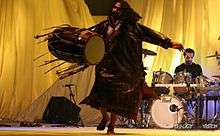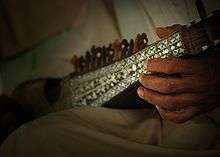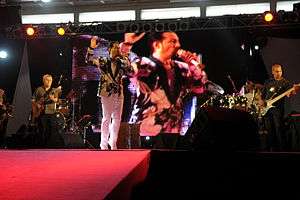Pashto music

| Music of Pakistan | |
|---|---|
 | |
| Genres | |
| Specific forms | |
| Religious music | |
| Ethnic music | |
| Other music | |
| Media and performance | |
| Music awards |
Hum Awards Lux Style Awards Nigar Awards Pakistan Media Awards ARY Film Awards |
| Music charts | Patari Haftanama |
| Music festivals |
All Pakistan Music Conference Lahore Music Meet Lok Virsa Mela |
| Music media |
Magazines Television Internet |
| Nationalistic and patriotic songs | |
| National anthem | Qaumi Taranah |
| Regional music | |
| |
Pashto music is commonly performed in Pakistan's Khyber Pakhtunkhwa province, northern Balochistan province and the Federally Administered Tribal Areas as well as parts of eastern Afghanistan and among the Pashtun diaspora. The major center for Pashto music and arts is found in Peshawar, Pakistan.
Genres
Tappa
Tappa is the oldest and most popular genre of the Pashto poetry. The Tappa is a composition of two unequal meters, in which the first line is shorter than the succeeding one, yet it reflects all human feelings and aspirations elegantly. Be it laborers, peasants, or women all sentiments find expression in the Tappa. It is also common among the Pashtuns that a boy of school would sing it, the elders in their hujrahs, the women in their home and Godar alike. It is the only song sung in the time of grief and on the occasion of marriage. In music it is sung with the traditional Pashto musical instruments rubab and mangai. Tappa has up to 16 different models of harmony and is being sung with full orchestra. In hujrah it's sung with rubab and sitar.
Charbeta
Charbetta is another popular genre, which consists of an epic poem with special rhythms. There are four kinds of Charbetta's. Normally, it's a poem of four lines but might also have six or eight lines. All aspects of life are discussed in it. That includes the heroic deeds and heroism by legendary figures and sometime expresses the romantic feelings. The tempo is usually very fast and is sung by two or more singers as part of a chorus in which ones singer reads the first line while the others follow the remaining. The singing or recitation of a Charbetta is called Tang Takore. Traditionally Charbetta is started just after the finishing of a Tappa.
Neemakai
Neemakai has many different forms and normally women compose it. It is usually very short (1 to 3 lines). The first lines are repeated in the middle of the song and Tappa is usually added according to the subject and circumstances. Most of these songs in Pashtoon culture have been expressed in different areas about daily life and love.
Loba

Loba is very popular among the masses and are added within Tappas occasionally. This is a form of folk music in which a story is told. It requires 2 or more persons who reply to each other in a poetic form. The two sides are usually the lover and the beloved (the man and woman).
Shaan
Shaan is sung during happiness such as marriages and or the birth of a child, and are sung in private congregations and social gatherings.
Badala
Badala is a professional form of folk music and consists of an epic poem or a ballad. Instruments used include the rubab, harmonium, mungey or tabla. In Badala, tribal traditions are the main theme as well as heroism, tragedies and romance. Badala consists of variations, because each couplet is varied in rhythms from other. It is sung traditionally at night.
Rubayi
Rubayi is a Pashto form of a Ghazal. The Rubayis of Rehman Baba are popular among the masses and is sung before the starting of Badala. As with the Ghazals, the Rubayi have been heavily influenced by Arabic, Persian and Turkish poetry.
Composers and performers

- Awalmir
- Sardar Ali Takkar
- Haroon Bacha
- Obaidullah Jan Kandarai
- Nashenas
- Naghma
- Farhad Darya
- Zeek Afridi
- Nazia Iqbal
- Rahim Shah
- Ahmad Wali
- Khyal Muhammad
- Gulzar Alam
- Zeb and Haniya
- Sajid & Zeeshan
- Ismail and Junaid
- Jehangir Aziz Hayat
- Ghazala Javed
- [ Tahir Khan ] the only Pustoon classical singer in Pakistan